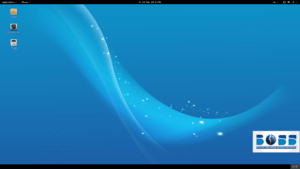Bharat Operating System Solutions
 | |
 Screenshot of BOSS Linux 6.1 running on a Laptop | |
| Developer | C-DAC/NRCFOSS |
|---|---|
| OS family | Unix-like |
| Working state | Current |
| Source model | Open source |
| Initial release | 10 January 2007 |
| Latest release | 6.2 (Anoop) / 30 March 2016 |
| Marketing target | Personal computers for Indians and the Indian Government |
| Available in | 19 languages |
|
List of languages Assamese, Bengali, English, Gujarati, Hindi, Kannada, Malayalam, Marathi, Odia, Punjabi, Sanskrit, Tamil, Telugu, Bodo, Urdu, Kashmiri, Maithili, Konkani and Manipuri | |
| Update method | APT (several front-ends available) |
| Package manager | dpkg |
| Platforms | IA-32, x86-64, PowerPC[1] |
| Kernel type | Monolithic (Linux) |
| Userland | GNU |
| Default user interface | GNOME |
| License |
Free software licenses (mainly GPL) |
| Official website |
www |
Bharat Operating System Solutions[2] (BOSS Linux) is a Linux distribution developed by C-DAC, Chennai in order to benefit the usage of Free/Open Source Software in India. BOSS Linux is a key deliverable of NRCFOSS. It has enhanced Desktop Environment integrated with Indian language support and other software. The latest stable release, version 6.0, was released in August 2015.
The software has been endorsed by the Government of India for adoption and implementation on a national scale.[3] It was developed at Centre for Development of Advanced Computing (CDAC), Chennai. BOSS Linux is an "LSB certified" Linux distribution: the software has been certified by the Linux Foundation for compliance with the Linux Standard Base standard.[4] BOSS Linux is derived from Debian Linux.
BOSS (Bharat Operating System Solutions)Linux distribution developed by C-DAC (Centre for Development of Advanced Computing) derived from Debian for enhancing the use of Free/ Open source software throughout India. BOSS Linux – a key deliverable of NRCFOSS has upgraded from entry-level server to advanced server. It supports Intel and AMD x86/x86-64 architecture. BOSS Linux advanced server has unique features such as web server, proxy server, database server, mail server, network server, file and print server, SMS server, LDAP server. BOSS Linux advanced server comprises administration tools such as webmin which is a web-based interface, Gadmin, PHP myadmin, PHP LDAP admin, PG admin. The accessibility of BOSS Linux will have a constructive impact on the digital divide in India as more people can now have access to software in their local language to use the Internet and other information and communications technology (ICT) facilities. Community Information centers (CICs) and internet cafes will also benefit from BOSS Linux as this software can be utilized to power these outlets and is affordable and easy to install, use and support.
Version history
BOSS 5.0 (Anokha)
This release came with many new applications mainly focused on enhanced security and user friendliness. The distribution includes over 12,800 new packages, for a total of over 37,493 packages. Most of the software in the distribution has been updated: over 20,160 software packages (this is 70% of all packages in Savir). BOSS 5.0 supports Linux Standard Base (LSB) version 4.1. The new version features XBMC to allow the user to easily browse and view videos, photos, podcasts, and music from a hard drive, optical disc, local network, and the internet.[5]
BOSS 6.0 (Anoop)
There are several major updates in BOSS Linux 6.0 (Anoop) from 5.0 (Anokha). Notable changes include a kernel update from 3.10 to 3.16, a shift for system boot from init to systemd, the full support of GNOME-Shell as part of GNOME 3.14, an update to the GRUB version, Iceweasel being replaced by Firefox and Pidgin replacing Empathy, and several repository versions of available programs being updated as part of the release.
BOSS Linux 6.0 also shipped with various application and program updates, such as updates to LibreOffice, Xorg, Evolution, GIMP, VLC, GTK, gcc, keyring manager, and Python.
Related specifically to the localization support, language support got even better with the replacement of Scim with Ibus with the Integrated System Settings. Now Indic languages enabled with Region and Languages are directly mapped to the Ibus and the OnScreenKeyboard layout is provided for all layouts.
This release is fully compatible with LSB 4.1.[6]
Releases
BOSS Linux has had six major releases through March 2015.[6]
| Legend: | Old version | Current stable version |
|---|
| Version | Code name | Kernel number | Desktop | Date of release |
|---|---|---|---|---|
| Evaluation | Sethu | 2.6.14-2-smp | GNOME 2.8 | |
| 1.0 | Tarag | 2.6.17-1-i386 | GNOME 2.14 | January 2006 |
| 2.0 | Anant | 2.6.21-1-486 | GNOME 2.18 | September 2007 |
| 3.0 | Tejas | 2.6.22-3-486 | GNOME 2.20 | September 2008 |
| 4.0 | Savir | 2.6.32-5-686 | GNOME 2.30.2 | April 2011 |
| 5.0 | Anokha | 3.10 | GNOME 3.4.2 | September 2013 |
| 6.0 | Anoop | 3.16.0-4-686 | GNOME 3.14.4 | August 2015 |
See also
References
- ↑ "BOSS Anoop Updated Installation Manual" (Retrieved on 2 February 2017)
- ↑ https://www.bosslinux.in/about-us
- ↑ "Make In India: Now government to have its own operating system, may replace Microsoft Windows in future", Manan Kumar, DNA India dated 14 September 2015 (Retrieved on 15 September 2015)
- ↑ The Product Directory of The Linux Foundation, LSB Certification Management System. Retrieved on 31 October 2008
- ↑ "Archived copy". Archived from the original on 18 September 2015. Retrieved 2015-12-05.
- 1 2 "BOSS GNU/LInux". cdac.in. Retrieved 2017-02-12.
External links
| Wikimedia Commons has media related to Bharat Operating System Solutions. |